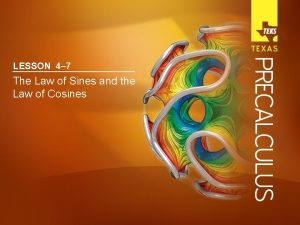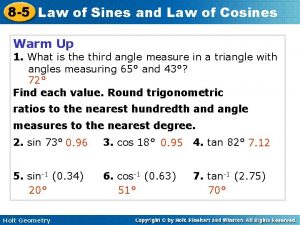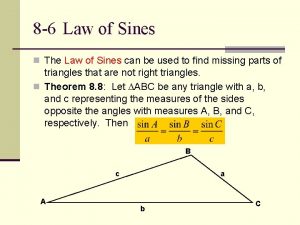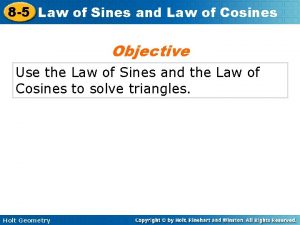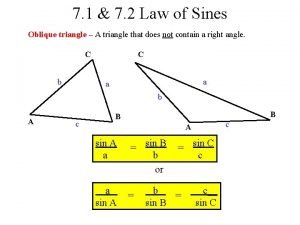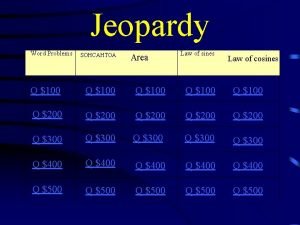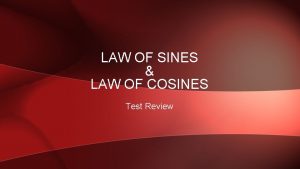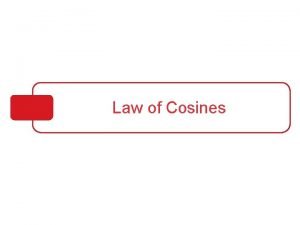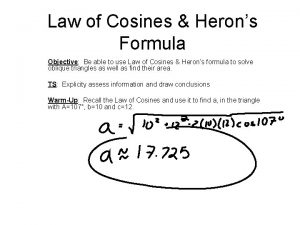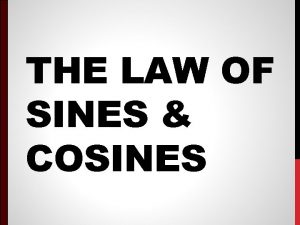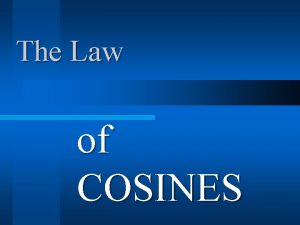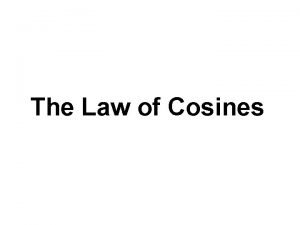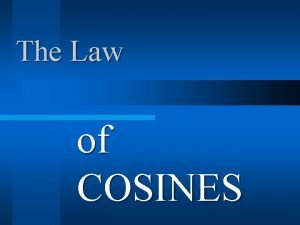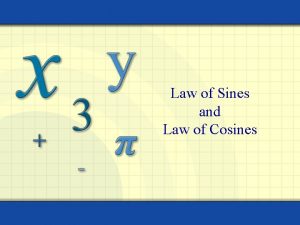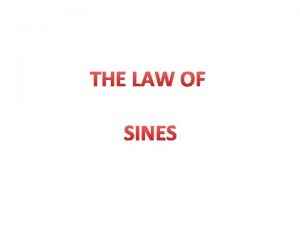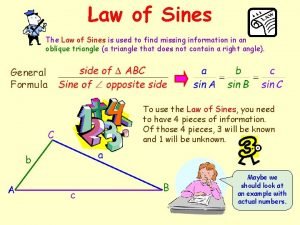Method 3 Law of Sines and Cosines Also










- Slides: 10

Method #3: Law of Sines and Cosines Also referred to as the analytical method.

Steps § § Draw a rough sketch of the vectors The resultant is determined using: § § § Algebra Trigonometry Geometry

These Laws Work for Any Triangle. A + B + C = 180° C Law of sines: a sin A b a = b = c sin B sin C Law of cosines: B A c c 2 = a 2 + b 2 – 2 abcos C

Example 2: using method 3 Stan is trying to rescue Kyle from drowning. Stan gets in a boat and travels at 6 m/s at 20 o N of E, but there is a current of 4 m/s in the direction of 20 o E of N. Find the velocity of the boat.

Example (using same problem) Stan is trying to rescue Kyle from drowning. Stan gets in a boat and travels at 6 m/s at 20 o N of E, but there is a current of 4 m/s in the direction of 20 o E of N. Find the velocity of the boat.

Calculating: Magnitude: c 2 = a 2 + b 2 – 2 abcos. C = (6 m/s)2 + (4 m/s)2 – 2(6 m/s)(4 m/s)cos 130° = 82. 85 c = 9. 10 m/s Direction: sin C = c sin 130° = 9. 10 sin B = 0. 337 R = 19. 67° + 20° R = 9. 1 m/s @ 39. 7° N of E sin B b sin B 4 B = 19. 67° = 39. 67°

Use the Law of: ¡ Sines when you know: l l 2 angles and an opposite side 2 sides and an opposite angle ¡ Cosines when you know: l 2 sides and the angle between them

Advantages and Disadvantages of the Analytical Method ¡ ¡ ¡ Does not require drawing to scale. More precise answers are calculated. Works for any type of triangle if appropriate laws are used. ¡ ¡ ¡ Can only add 2 vectors at a time. Must know many mathematical formulas. Can be quite time consuming.

This completes Method Three! Keep up the good work! This is our last time in class to learn these. problems #5, 6 due tomorrow

Another Problem Paul is on a railroad flat car which is moving east at 20. 0 m/s (Vcg = velocity of the car relative to the ground). Paul walks on the flat car at 5. 0 m/s @ 40. 0 o N of E as shown (Vpc = velocity of Paul relative to the car). What is Paul’s velocity relative to the ground (Vpg = velocity of Paul relative to the ground)? Vpg = 24 m/s @ 7. 7 o (or 7. 7 o N of E)
 4-7 the law of sines and the law of cosines
4-7 the law of sines and the law of cosines 8-6 practice the law of sines and law of cosines
8-6 practice the law of sines and law of cosines 8-6 the law of sines and law of cosines
8-6 the law of sines and law of cosines 8-5 law of sines and law of cosines
8-5 law of sines and law of cosines Trigonometry maze
Trigonometry maze Law of sines and cosines word problems worksheet doc
Law of sines and cosines word problems worksheet doc Sohcahtoa problems
Sohcahtoa problems Ambiguous case
Ambiguous case Law of sines and cosines test
Law of sines and cosines test Law of cosines sss
Law of cosines sss Area using law of cosines
Area using law of cosines
